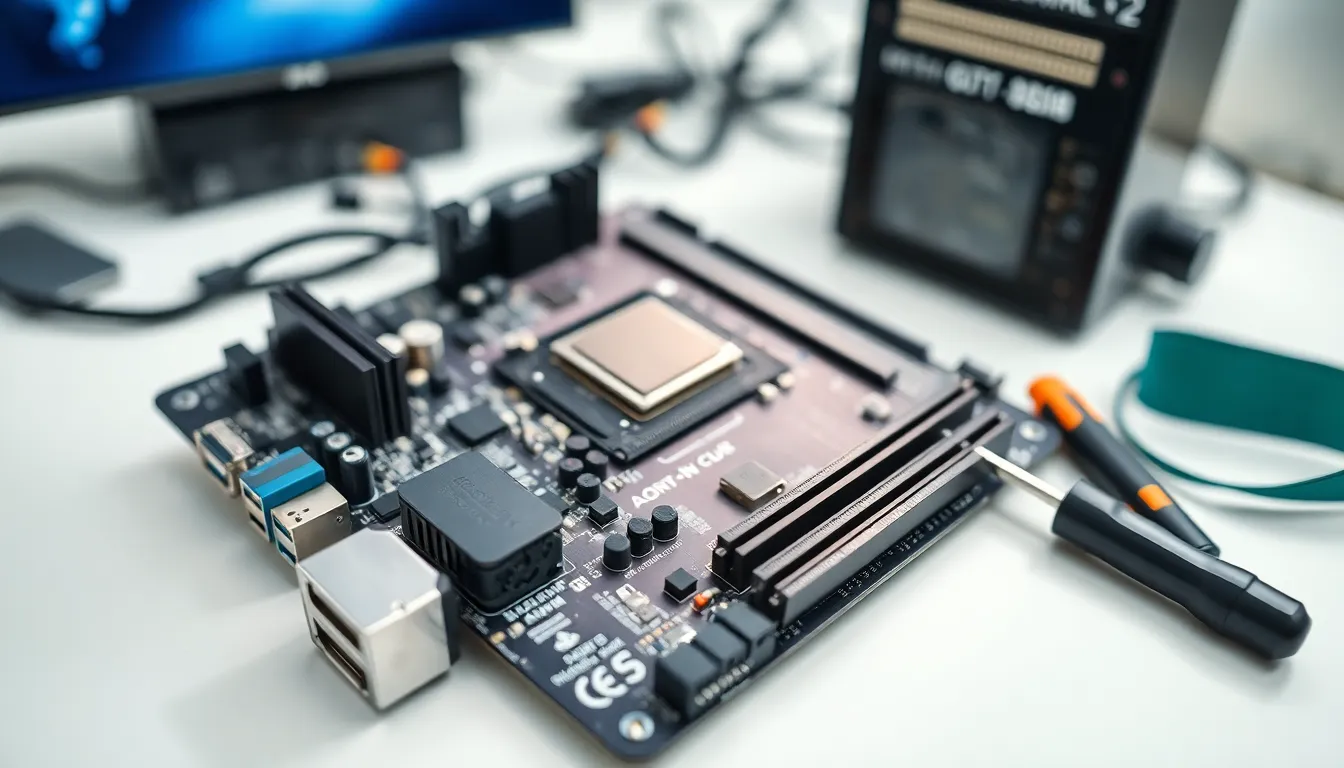Table of Contents
ToggleIn today’s tech-driven world, hardware forms the backbone of every device we rely on, from smartphones to powerful servers. Understanding hardware is crucial for anyone looking to navigate the ever-evolving landscape of technology. It’s not just about the components; it’s about how they work together to deliver performance, efficiency, and reliability.
As technology advances, hardware continues to innovate, pushing the boundaries of what’s possible. Whether it’s the latest graphics card enhancing gaming experiences or cutting-edge processors powering complex computations, hardware plays a pivotal role in shaping our digital lives. This article delves into the essentials of hardware, exploring its significance and the emerging trends that are transforming the industry.
Overview Of Hardware
Hardware encompasses the physical components of a computer system or electronic device. These components include central processing units (CPUs), graphics processing units (GPUs), memory modules, storage drives, and motherboards. Each hardware item plays a crucial role in overall system performance.
| Component | Function |
|---|---|
| CPU | Processes instructions and handles tasks |
| GPU | Renders graphics and accelerates visuals |
| Memory module | Stores data temporarily for quick access |
| Storage drive | Stores data permanently for long-term use |
| Motherboard | Connects all components and facilitates communication |
In modern computing, hardware advancements occur rapidly. Innovations in CPU architecture enhance processing power while reducing energy consumption. Graphics cards with cutting-edge technology support high-resolution gaming and professional design applications. Solid-state drives (SSDs) continue replacing traditional hard drives, offering faster data access speeds.
Trends in hardware development include miniaturization, where smaller components deliver more power and efficiency. The rise of artificial intelligence (AI) and machine learning (ML) technologies drives demand for specialized hardware solutions. These include tensor processing units (TPUs) that accelerate AI algorithms and unique configurations designed for optimal performance in data-heavy tasks.
Understanding hardware’s role is essential for optimizing system performance. Users should consider compatibility and upgrade paths when selecting components. By integrating the latest hardware technologies, users can enhance device capabilities, increase productivity, and improve overall user experience.
Types Of Hardware

Various types of hardware exist, each playing a specific role in computing systems. Understanding these types helps users optimize their devices effectively.
Input Devices
Input devices enable users to interact with computers and provide data. Common input devices include:
- Keyboards: These devices capture typed input, allowing users to enter text and commands.
- Mice: Mice translate physical movement into cursor movement, facilitating navigation within graphical user interfaces.
- Touchscreens: Touchscreens detect touch input, enabling direct interaction with displayed content.
- Scanners: Scanners convert physical documents or images into digital formats for processing or storage.
- Microphones: Microphones capture audio input, used in voice recognition applications and communication tools.
Output Devices
Output devices present data processed by computers. Key output devices consist of:
- Monitors: Monitors display visual output from the computer, ranging from text to complex graphics.
- Printers: Printers convert digital documents into physical copies on paper, utilizing various printing technologies.
- Speakers: Speakers output audio signals, providing sounds from multimedia sources or applications.
- Projectors: Projectors display visual content on larger surfaces, facilitating presentations or group viewings.
- Headphones: Headphones deliver audio directly to the user, enhancing personal listening experiences.
Storage Devices
Storage devices retain data for access and use. Major types of storage devices include:
- Hard Disk Drives (HDDs): HDDs utilize spinning disks to read and write data magnetically, offering large storage capacities at lower costs.
- Solid-State Drives (SSDs): SSDs use flash memory to store data, providing faster access speeds and improved durability compared to HDDs.
- USB Flash Drives: USB flash drives offer portable storage solutions, easily connecting to computers via USB ports.
- Optical Discs: Optical discs, like CDs and DVDs, store data using laser technology for reading and writing information.
- Cloud Storage: Cloud storage allows users to save and access data online, providing flexibility and remote access.
Processing Units
- Central Processing Units (CPUs): CPUs act as the primary processor, executing instructions and managing system tasks.
- Graphics Processing Units (GPUs): GPUs accelerate rendering and image processing, essential for graphics-intensive applications and gaming.
- Field-Programmable Gate Arrays (FPGAs): FPGAs enable custom hardware configurations for specific tasks, used in embedded systems and specialized applications.
- Digital Signal Processors (DSPs): DSPs focus on processing signals, optimizing audio, video, and communication systems.
- Application-Specific Integrated Circuits (ASICs): ASICs are designed for specific tasks, providing efficient performance for specialized computing needs.
Key Hardware Innovations
Hardware continues to evolve rapidly, driven by technological advancements and changing user needs. Recent breakthroughs enhance performance, efficiency, and functionality across various computing devices.
Recent Advancements
- CPUs: Recent developments in CPU architecture focus on improved multi-core designs and energy efficiency. Examples include AMD’s Ryzen series and Intel’s Alder Lake processors, which deliver superior performance for gaming and professional applications.
- GPUs: Innovations in GPU technology emphasize real-time ray tracing and AI-driven graphics. The NVIDIA GeForce RTX series showcases these features, enhancing gaming realism and computational capabilities.
- SSDs: The shift from traditional hard drives to SSDs continues, with NVMe (Non-Volatile Memory Express) SSDs offering significantly higher speeds. Companies like Samsung and Western Digital lead the market with their high-capacity solutions.
- Motherboards: Advancements include support for faster memory speeds and improved connectivity options like PCIe 4.0. ASUS and MSI manufacture motherboards that leverage these technologies for enhanced system performance.
Future Trends
- Miniaturization: Ongoing miniaturization of components aims to create more compact and powerful devices. Innovations in silicon technology facilitate smaller chips without sacrificing performance.
- AI and ML Hardware: The demand for specialized hardware solutions tailored for AI and machine learning increases. Companies develop Neural Processing Units (NPUs) and Tensor Processing Units (TPUs) to accelerate AI workloads.
- Quantum Computing: Future breakthroughs in quantum hardware may revolutionize processing capabilities. Developing qubit technology by companies like IBM and Google promises significant advancements in computation speed and complexity.
- Sustainable Hardware: Emphasis on sustainable development leads to eco-friendly production methods and materials. Hardware manufacturers focus on reducing environmental impact while maintaining performance and reliability.
Choosing The Right Hardware
Selecting suitable hardware is crucial for optimal device performance. Multiple factors influence the decision-making process, along with common mistakes that can hinder users.
Factors To Consider
- Compatibility: Ensure components work seamlessly together. Check motherboard specifications to confirm CPU and RAM compatibility.
- Performance Requirements: Assess the intended use, such as gaming or productivity, to choose components that meet specific demands.
- Budget: Set a clear budget for hardware purchases. Compare prices and features to find suitable options without overspending.
- Future Upgrades: Consider hardware that allows for future enhancements. Opt for modular components like SSDs or additional RAM slots to extend system longevity.
- Power Supply: Select a power supply unit (PSU) that supports the energy needs of all components. Calculate the total wattage requirement for stable operation.
- Cooling Solutions: Evaluate cooling requirements based on usage scenarios. Utilize adequate cooling systems to maintain optimal performance and longevity of components.
Common Mistakes
- Ignoring Compatibility: Purchasing incompatible components can lead to system failures. Always verify specifications before making a decision.
- Overlooking Cooling Needs: Neglecting proper cooling can result in overheating. Ensure a suitable cooling solution is in place for high-performance components.
- Underestimating Power Requirements: Selecting an insufficient PSU can cause instability. Factor in peak power consumption when choosing a power supply.
- Focusing Solely on Price: Choosing the cheapest option may compromise performance. Balance cost with functionality and reliability.
- Neglecting Future Enhancements: Failing to consider upgrade paths can limit the device’s lifespan. Choose components that allow for easy upgrades as technology advances.
- Rushing the Selection Process: Making snap decisions often leads to buyer’s remorse. Take time to research and compare options thoroughly.
Hardware serves as the backbone of modern technology enabling devices to perform efficiently and reliably. Understanding the intricate relationships between various hardware components is crucial for optimizing performance and enhancing user experience. As technology continues to evolve with innovations like AI and miniaturization, staying informed about the latest advancements becomes essential for anyone looking to upgrade or build their systems.
By making informed decisions and considering factors like compatibility and future upgrades, users can ensure their hardware choices meet their needs. Embracing sustainable practices in hardware development also plays a vital role in shaping a responsible tech landscape. The future of hardware holds exciting possibilities that can transform the way users interact with technology.






